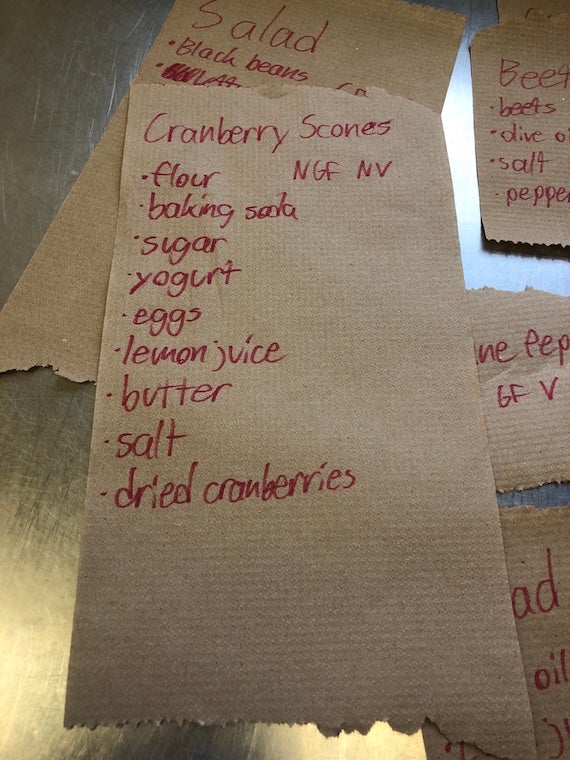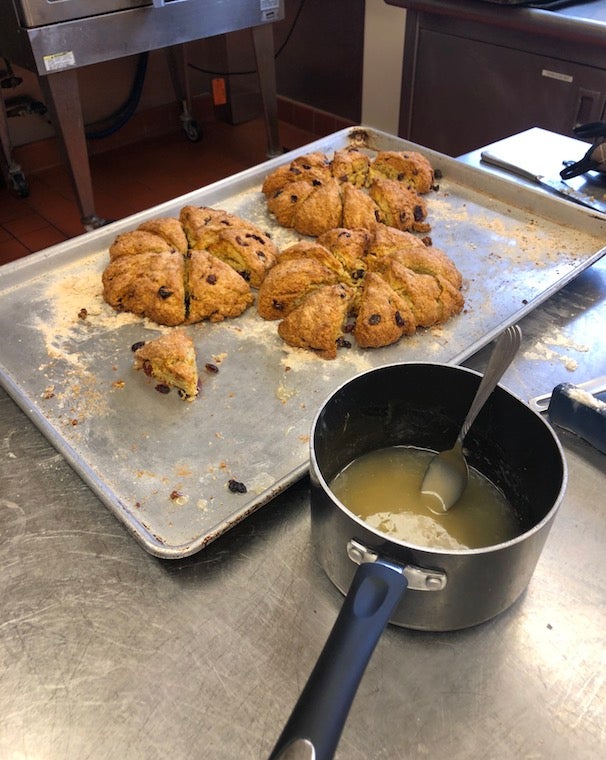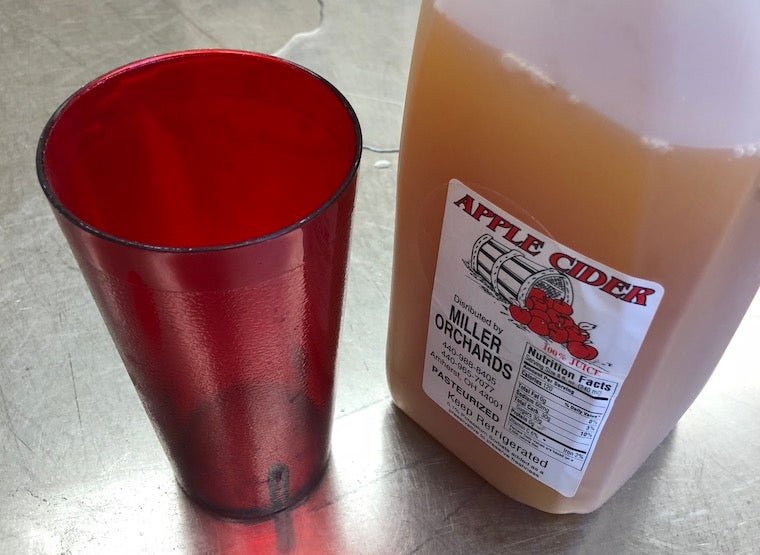Oberlin Blogs
Co-op Thursday
December 8, 2019
Claire O’Brocta ’23
(Disclaimer: This blog is written as if today was Thursday, December 5th. Unfortunately, it was not uploaded until Sunday, so from here on out, let’s pretend it’s Thursday!)
When I walked into my co-op at 11:20 this morning, I didn’t expect to see one of my fellow co-opers grating butter.
She had a fruit zester in her hand and a very large chunk of dairy on the counter below. The shredded product protruding from the blade looked like cheese. I couldn’t believe it was butter! I had never seen this happen before, and I didn’t even realize it was a thing that people did.
Walking into my co-op at exactly 11:20 am on a Thursday is a weekly tradition for me, thanks to my scheduled cook shift. I don’t see sights as unusual as someone grating butter when I step foot in the kitchen each week, but there’s always an element of surprise in what exactly will be going on.

In both of the co-ops I’ve been in during my three semesters at Oberlin, meals are prepared over the two-hour time period before they’re served. Each meal has at least one head cook, who supervises the shift and decides what to make. The head cook is also ServSafe trained, to make sure that the food is safely served (as the name probably implies). Alongside the head cook, various co-opers take a one or two hour shift to help prepare the meal. For Thursday lunch in my co-op, Keep, there are three of us who help out the head cook. Two of them cook both hours, but I’m only there for the second, which is why they’re always well on their way when I walk in, and I can be surprised by butter-related happenings.
I eventually learned that the butter grating was going on because we were making scones! Co-op meals are required to have a protein, starch, and vegetable component (plus substitutes for people with dietary restrictions), but if there’s extra time, many head cooks will tack a special treat onto the menu. Today, that treat was cranberry scones with a lemon glaze. The rest of the meal consisted of roasted beets, rice, and a taco salad, which featured lettuce, tomato, onion, and black beans (spicy peppers and a lime dressing were served on the side). Each of those components was already cooking when I got there, so I got to help with the scones.
The butter grating duties were passed onto me, as my fellow co-oper Dawn, who was previously doing the grating, mixed the resulting shreds in with some dry ingredients. I learned that it’s surprisingly fun to grate butter, and very satisfying! I’m glad I had gloves on, though, because the butter certainly would have gotten all over my hands otherwise. While we did that, the other person on our shift whisked together the wet ingredients, and our head cook kept an eye on the rest of the meal.
Once I was done with the butter, I had to get the cranberries from the walk-in fridge. I always enjoy going into the walk-in, because I get to take a look at all the fun produce the co-op has in stock. Ingredients that stuck out to me today were oyster mushrooms (one of my favorite kinds of mushrooms!) and dates, neither of which I had seen in the co-op before. In Keep, the walk-in fridge is located inside of the room where we keep our dry foods. As I was passing through that room, I noticed some tortilla chips, another fun thing we’ve never had here before! Having so many new and exciting ingredients definitely brightens up the cold, cloudy, and very stressful end of the semester.

While I was in the fridge, the wet and dry ingredients for the scones were combined. All that was left to add before the dough went onto the pans were the cranberries! Once they were mixed in, Dawn began forming the dough into mounds, and I started to pre-crew. Crew is what we call the hour long clean-up shift that happens after each co-op meal, so pre-crewing happens when people begin to fulfill those duties during the cook shift. It’s a good task to take on when there’s a lot of time left in the kitchen and not much left to do, because it makes the real crew shift significantly easier for the people on it. I’ll go more into detail about what actual crew entails later in this blog, but pre-crew generally consists of putting away ingredients, and clearing the kitchen counters of all cutting boards, mixing bowls, and utensils. The kitchenware items are then brought to the pot sink. If any of them are filled with food remnants, it’s helpful to spray them down while pre-crewing too.

My next task was to slice the newly sugar-coated dough mounds into actual scones! This involved cutting each circle into eighths, dipping the knife into flour after each slice to prevent sticking. With that, the first batch was ready to go in the oven, and it was time to get started on save plates.

When a co-oper can’t make it to a meal, they can request a save plate, which is a plate of food assembled by the cook shift that is available for the co-oper to grab whenever they want. Save plates are left in the serving area during mealtime in case their recipients want to grab them then, and whichever plates are left after mealtime are wrapped up by the crew shift and put into the fridge. If a save plate isn’t eaten in 24 hours, it expires, and the crew shift composts whatever’s left on it. How exactly save plates are requested differs by co-op. Fairkid, the co-op I was in last year, had a Google Sheet document with a column for each meal of the week. Co-opers would write their name and dietary restrictions (and other special requests, such as “extra protein” or “no brussels sprouts”) under the meal they wanted a save plate for. Keep’s policy this year involves a special email account strictly for save plate purposes. If someone wants a save plate, they email the same information that would go on Fairkid’s chart to this account, along with the meal they’re requesting a save plate for (Thursday lunch, for example). Each head cook has access to the email account, so they can pull it up during the shift and see who needs a save plate that day.

Today we had ten save plates, all of which had to be labeled and loaded up with food. Once a component of the meal was on every save plate, we could take it out to the serving area. Often times, since we make enough food for about 75 people, pots of food are large and heavy, and taking them out is a two-person job! After we put the food out, we add an ingredients list beside it so that everyone knows exactly what they’ll be eating. In Fairkid, we had a whiteboard at the head of the serving tables with all of the ingredients lists on it, but in Keep, we make separate ingredients lists for each dish, which are most often written on paper towels and placed beside their corresponding food.

At this point, all of the food could be taken to the serving area. The only exception was the scones, which had just come out of the oven. While they were baking, Dawn whipped up a lemony glaze, and after she gently tore the wedged treats away from their congregations on the pan, she carefully drizzled the sticky glaze atop each one. With that, the scones were finally done, and they looked beautiful!

Perhaps my favorite part of each Thursday lunch cook shift is the end. This isn’t because the shift itself isn’t enjoyable, but rather because Keep gets our delivery from the local apple orchard on Thursdays, and that means our shift is the first to crack open the week’s supply of apple cider! Because of this, every week, the four of us celebrate the conclusion of our hard work with a cider toast, and it’s fantastic.

Eventually, 12:20 pm comes around, and the members of Keep can officially start serving themselves lunch. Officially, mealtime lasts from then until 1:00. This is when lunch crew commences, and the leftover food begins to be composted so the dishes can be cleaned. I’m not on Thursday lunch crew, so I was on my way to class at this point. I did, however, snag some extra scones (that would have otherwise been composted), and brought them down to the TIMARA department, where they were readily consumed by sleep-deprived music students.

I found myself back at Keep just over five hours later for dinner, which begins at 6:20 pm. Tonight, our meal consisted of pasta with homemade tomato sauce, tofu, and a spinach and pear salad with balsamic dressing. The meal was tasty, but unlike lunch, I wasn’t able to leave right after I finished eating it. In all of Oberlin’s co-ops, each member has to crew once a week, and Thursday night is my turn! Between my lunch cook shift and my dinner crew, Thursday is a very co-opy day for me this semester.
Remember when I said I’d explain more about crew later in the blog? Well, we have officially arrived at that point! In any given crew shift, there are 3 to 5 people, and three main roles. The first role is running the Hobart, our dish sanitizing machine. Whoever takes up this role is responsible for spraying down all of the plates, and running them (along with the cups, silverware, and compost buckets) through the Hobart. The second role is pot sinking, which involves washing pots, pans, cutting boards, and whatever else can’t be run through the Hobart. The remainder of people on crew fulfill the third role, which I like to call the odd jobs (when I crew, odd jobs is the role I prefer to take on). This involves composting, sweeping, mopping, wiping surfaces, wrapping save plates, logging fridge temperatures, and any other miscellaneous things that need to be done to clean the kitchen. If no pre-crewing was done, these people might also need to put away ingredients and clear the counters. On a five-person crew, someone in this role could be dedicated to helping out the people Hobarting and pot sinking, by putting away dishes and doing whatever else will make their jobs go faster.
Today at 7:00 pm, I put on my apron and got started with my first crew task, which was wrapping up save plates. Throughout my shift, however, I did at least a little bit of every task I listed above under the odd jobs role. On three-person crew shifts, one person is typically responsible for the entirety of those tasks (unless someone in a different role finishes early enough), but we luckily had four people today, so I could split the responsibilities with someone else. Crews are allotted an hour to get everything done, but they can take more or less time depending on the efficiency of the members, and how clean the kitchen is ahead of time. Our crew is lucky, because the Thursday dinner cook shift pre-crews a lot! This allows us to consistently finish crew on time or early. Plus, it’s nice to start your shift by walking into a kitchen that’s not too dirty. Last spring, I often felt an overwhelming sense of dread when I entered the kitchen on crew days, because it would typically be as messy as you can imagine, and we had a relatively inefficient group. Between these factors, our crew shift rarely finished on time. Luckily, the speed of my crew this semester makes up for it, and my experience last semester makes me especially grateful for the relative ease of my shift this go around. As this term wraps up, I can only hope I get a smooth crew again next semester!

Speaking of the semester wrapping up, I only have one more co-op Thursday like this. A week from today is the last day of classes, and also my last day of normal co-op shifts for the semester! I’m going to miss these Thursdays, but probably not too much, considering I’ll be in Keep again in the spring. I’ve enjoyed my time in this co-op so far, so I’m definitely excited to have another shot at it in February. In the meantime, maybe I’ll make some scones. I know how to grate butter now, and that’s the most important part, right?
Similar Blog Entries
A Vegetarian Guide to Reliable Protein Sources
January 20, 2025
Prior to move-in day, I know I would have felt so much relief had another picky vegetarian Obie shared their eating routines.

A love letter to my village house
December 25, 2024
My experience living in a village house on campus.

